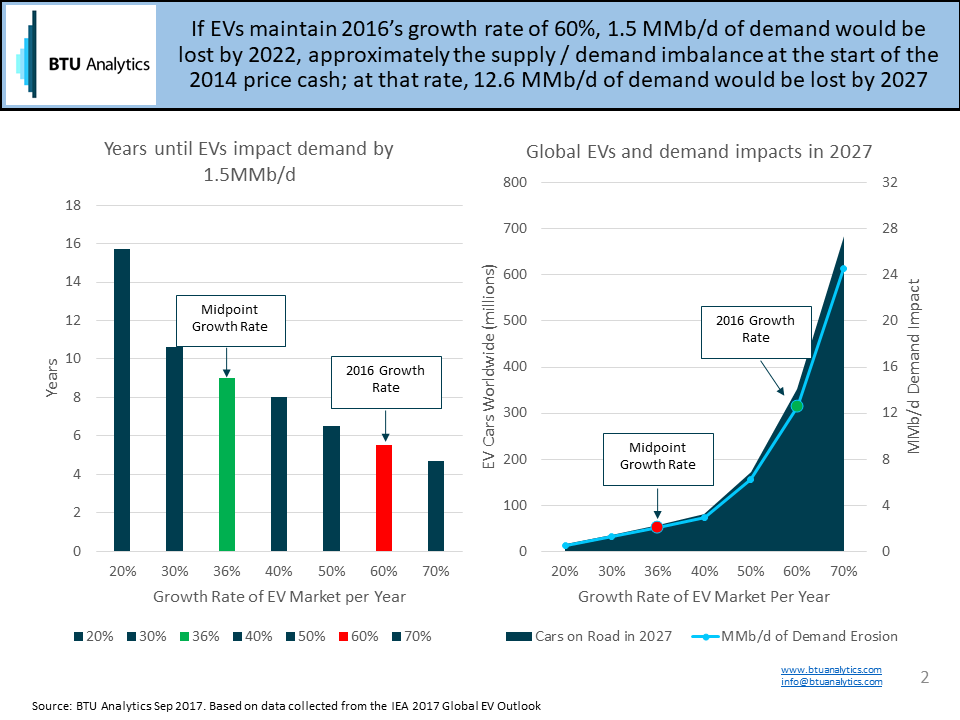BTU Analytics recently estimated the impact that electric vehicles (EV) could have on US natural gas markets due to incremental power burn demand. The flip side of the EV discussion is to understand how much EVs will impact oil markets. Many sources, including the supermajors, claim that gasoline demand lost from EV adoption will be minimal, but understanding what assumptions could result in a meaningful impact on oil markets is a good exercise. For this discussion, ‘EV’ includes both pure electric vehicles that have no gasoline component and plug-in hybrid electric vehicles (PHEV) that use both gasoline and electricity.
Using the same assumptions underlying the model used in the natural gas analysis, we included assumptions to estimate the impact on gasoline. According to BTU Analytics’ back-of-the-napkin estimates, making a simplifying assumption that all gasoline ‘savings’ are direct reductions in demand, each PHEV saves 437 gallons of gas per year and 624 for pure EVs.

Using the EIA’s estimate of 10.5 million EVs by 2027 in BTU Analytics’ model, 373 Mb/d of gasoline demand could be eliminated, which equates to approximately 4.7% of the EIA’s projected US consumption in 2027. While 373 Mb/d of demand erosion in the US isn’t necessarily enough to spur a global meltdown, the US is not the epicenter of EV sales. In 2016, China had twice as many new EV registrations as the US, and Europe had about 30% more than the US.
The IEA’s 2017 Electric Vehicle Outlook estimates that automaker and country-stated targets are projecting between 120 and 160 million EVs by 2030. Developing countries like India and China that have large, growing middle classes will see a significant portion of the growth. Per the IEA, India alone targets nearly 60 million by 2030, and 14 countries currently have stated EV targets, many of which provide incentives to purchase electric vehicles. Taking a midpoint of 140 million, the global market needs to average approximately 35.5% growth each year to reach that target from the IEA’s estimated 2016 total of 2 million. At 140 million EVs, global demand could be reduced by over 5 MMb/d, but far-reaching impacts would be felt long before then.
When oil prices crashed in 2014, the world was long supply by 1.5 – 2.0 MMb/d, so let’s look at what it would take to reach that level of impact. At a 35.5% growth rate, which we’ll call the ‘midpoint growth rate’, EVs will have that magnitude of an impact by 2026. But what if the market grows faster than that? Last year, the EV market grew by 60% according to the IEA, and that growth is in line with what some automakers project over the next several years. If that happens, the demand impact would reach 1.5 MMb/d four years earlier in 2022. Looking out to 2027, the difference between the 35.5% growth case and the 60% growth case is over 10 MMb/d. The charts below show the difference that EV growth rates have on reaching the 1.5 MMb/d level and how those growth rates would impact the market if they were sustained over the next 10 years.

While there are many other factors in play, electric vehicles could have a material impact on oil demand. Step-changes in technology can facilitate rapid adoption, such as what happened with cell phones. In developing countries, the new technology leapfrogged legacy technology, and accelerated growth faster than anyone predicted. If subsidies for EVs continue, and if capabilities like autonomous vehicles and battery technology become economically feasible, or even advantageous, over the next five years, then they can capture a much larger portion of the market than many are predicting now.
To get detailed analysis of all major dynamics impacting oil supply and demand, request a copy of the Oil Market Outlook today.








